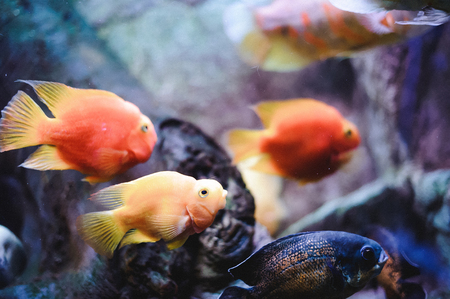Introduction to Aquarium Lighting
When setting up an aquarium, lighting might seem like just another item on your checklist, but it plays a huge role in creating a healthy and beautiful tank. The right kind of lighting doesn’t just make your fish look stunning — it also helps support the life cycles of both plants and animals inside your tank. In the U.S., many aquarium hobbyists debate between LED and fluorescent lights, and understanding why proper lighting matters can help you make the best choice for your aquatic pets.
Why Is Aquarium Lighting Important?
Aquarium lighting serves several important functions:
- Showcasing Colors: Good lighting brings out the natural colors of your fish, corals, and plants, making your tank more attractive.
- Supporting Plant Growth: For tanks with live plants, proper lighting is essential for photosynthesis so plants can thrive.
- Mimicking Natural Environments: Fish and other aquatic creatures are used to certain light cycles in nature. Replicating these patterns helps reduce stress and keeps them healthier.
- Regulating Fish Behavior: Many fish rely on changes in light to know when it’s time to be active or rest. Consistent lighting routines promote normal activity and sleep patterns.
The Visual Impact: Making Your Tank Pop
Lighting isn’t just about function — it’s also about style. Whether you want your aquarium to be the centerpiece of your living room or simply a peaceful spot in your home office, the type of lighting you choose will affect how vibrant and appealing your tank looks. Here’s a quick comparison of how different lighting types can impact tank aesthetics:
| LED Lighting | Fluorescent Lighting | |
|---|---|---|
| Color Options | Wide range; customizable effects | Limited; mostly cool white or blue tones |
| Brightness Control | Easily adjustable | Usually fixed intensity |
| Tank Ambiance | Sleek, modern look; highlights details | Softer, traditional glow |
The Health Factor: Keeping Aquatic Life Thriving
The health of your aquarium’s residents depends heavily on getting the light just right. Too little light can stunt plant growth and leave fish dull-colored and sluggish. Too much light may encourage unwanted algae growth or stress out sensitive species. Choosing between LED and fluorescent lights isn’t just a matter of taste — it’s about finding what works best for your specific tank setup and its inhabitants.
Overview of LED and Fluorescent Lighting
When setting up an aquarium, choosing the right lighting is a big deal for both the look of your tank and the health of your fish and plants. In the U.S., the two most popular options are LED (Light Emitting Diode) and fluorescent lights. Let’s break down what each type is, how they work, and why American aquarists use them in their tanks.
How LED Aquarium Lighting Works
LEDs use small diodes to produce light when an electric current passes through them. These lights are energy-efficient, run cool, and can last for years without needing replacement. Many modern LED fixtures come with features like adjustable color spectrums, dimmers, and even smart timers you can control from your phone. Theyre popular among hobbyists who want a sleek look and customizable lighting effects for their freshwater or saltwater tanks.
How Fluorescent Aquarium Lighting Works
Fluorescent lights use tubes filled with gas that emit light when electricity excites the gas inside. There are different types such as T8, T5, and compact fluorescents, each with slightly different sizes and efficiency levels. Fluorescent bulbs have been around for decades in American aquariums because they give off a strong, broad-spectrum light that works well for growing aquatic plants and corals. However, they do generate more heat than LEDs and usually need to be replaced every 6–12 months.
Common Usage in U.S. Home Aquariums
| Lighting Type | Typical Use | Main Benefits |
|---|---|---|
| LED | Freshwater & Saltwater tanks; planted aquariums; reef tanks | Energy-saving, long-lasting, customizable colors |
| Fluorescent | Planted tanks; beginner setups; budget-friendly aquariums | Good light output, affordable upfront cost |
Both LED and fluorescent lights are easy to find at pet stores across America, and either option can help you create a beautiful aquarium environment. The best choice depends on what kind of tank you have, your budget, and how much time you want to spend maintaining your setup.
![]()
3. Key Differences Between LED and Fluorescent Lights
When it comes to choosing the best lighting for your aquarium, understanding the main differences between LED and fluorescent lights is super important. Both options have their own unique features, but some stand out more than others. Let’s break down the key contrasts in a way that’s easy to understand.
Energy Efficiency
LED lights are known for being highly energy-efficient. They use significantly less electricity compared to fluorescent bulbs, which means lower utility bills for you. This makes LEDs a popular choice for many American households aiming to save on energy costs.
Lifespan
The lifespan of your aquarium light is another crucial factor. LEDs typically last much longer than fluorescents—sometimes up to 50,000 hours or more! In contrast, fluorescent bulbs often need replacing after about 6,000 to 15,000 hours. That means fewer trips to the pet store and less hassle overall with LEDs.
Color Spectrum
Both LED and fluorescent lights can provide a range of colors, but LEDs offer more precise control over the color spectrum. This helps you customize the look of your tank and meet the needs of both plants and fish. With programmable settings, LEDs can even mimic natural sunlight or moonlight, giving your aquarium a more authentic feel.
Heat Output
LEDs generate very little heat compared to fluorescent bulbs. This matters because too much heat can raise your tanks water temperature, stressing out your aquatic pets. With LEDs, you don’t have to worry as much about overheating, making them safer for sensitive species.
Upfront Costs
One thing to keep in mind is that LED lights usually come with a higher initial price tag than fluorescents. However, since they last longer and use less energy, many aquarists find that LEDs save money in the long run.
Quick Comparison Table
| Feature | LED Lights | Fluorescent Lights |
|---|---|---|
| Energy Efficiency | Very high; uses less power | Moderate; uses more power |
| Lifespan | Up to 50,000+ hours | 6,000–15,000 hours |
| Color Spectrum Control | Highly customizable | Limited options |
| Heat Output | Low heat production | Can produce noticeable heat |
| Upfront Cost | Higher initial cost | Lower initial cost |
This table highlights the main differences between LED and fluorescent aquarium lights at a glance so you can pick what works best for your tank and budget.
4. Pros and Cons for Your Aquarium
Comparing LED and Fluorescent Lighting for American Aquariums
When choosing the right lighting for your aquarium, its important to weigh the benefits and drawbacks of LED and fluorescent options. Lets break down how each type stacks up for U.S. hobbyists, especially in terms of plant growth, maintenance, and how well they fit with common American tank setups.
LED Aquarium Lighting
| Pros | Cons |
|---|---|
|
|
Fluorescent Aquarium Lighting
| Pros | Cons |
|---|---|
|
|
Main Considerations for American Hobbyists
- If you have a planted aquarium and want lush growth with minimal hassle, LEDs offer better customization for different plant needs and are easier to manage long-term.
- If you’re on a budget or have an older tank setup (like those common in U.S. pet stores), fluorescent lights remain a practical choice but will require more frequent upkeep.
A Quick Comparison at a Glance
| LEDs | Fluorescents | |
|---|---|---|
| Lifespan (years) | 5–10+ | <1 (bulb replacement) |
| Energy Use | Low | Moderate–High |
| Plant Growth Support* | Excellent (with proper model) | Adequate (low-medium plants) |
| Maintenance Needed | Minimal | Frequent bulb changes |
*For high-demand aquatic plants, always check the fixture’s PAR rating or consult your local aquarium shop for recommendations suited to your specific tank size and plant types.
5. Choosing the Best Lighting for Your Tank
Picking the right lighting for your aquarium can make a big difference in the health of your fish and plants, as well as how great your tank looks. When deciding between LED and fluorescent lights, it helps to think about your specific needs, the type of tank you have, and what’s best for your aquatic pets.
Consider Your Tank Type
The size and type of your tank will help determine which lighting is best:
| Tank Type | Best Lighting Option | Why? |
|---|---|---|
| Freshwater Community Tanks | LED or Fluorescent | Both work, but LEDs are more energy-efficient and last longer. |
| Planted Aquariums | LED (Full Spectrum) | LEDs provide customizable light that promotes plant growth. |
| Saltwater/Reef Tanks | High-Output LED | LEDs can mimic natural sunlight and support corals. |
| Breeder Tanks/Quarantine Tanks | Basic LED or Fluorescent | Cost-effective options are fine since aesthetics aren’t a priority. |
Main Factors for U.S.-Based Hobbyists to Consider
1. Energy Efficiency and Cost
LED lights use less electricity than fluorescents, helping you save on utility bills—an important factor with rising energy costs in the U.S. While the upfront cost of LEDs can be higher, they last much longer, so you’ll buy fewer replacements over time.
2. Light Customization
If you want to adjust colors or set up day/night cycles, many LED systems come with handy features like timers and remote controls. This is especially helpful if you’re often away from home or want to automate your tank lighting.
3. Heat Output
Fluorescent bulbs produce more heat than LEDs, which can raise the water temperature—something to watch out for if you live in warmer states or keep sensitive fish species.
4. Availability of Replacement Parts
Most major pet stores across the U.S. stock both LED and fluorescent bulbs, but LEDs are quickly becoming the standard. Check what’s easily available near you before making a decision.
Matching Lighting to Your Fish and Plants
| Aquarium Inhabitants | Recommended Lighting Type |
|---|---|
| Tropical Fish (no live plants) | Basic LED or Fluorescent (soft white light) |
| Cichlids, Goldfish, Betta Fish | LED with adjustable brightness for better color display |
| Aquatic Plants (like Anubias, Java Fern) | Full-spectrum LED for optimal growth |
| Coral Reef Species | High-output reef LEDs with blue/white balance |
Your Aquarium Goals Matter!
If you’re just starting out or have a simple freshwater setup, a basic LED fixture is usually all you need. If you’re aiming for lush plant growth or keeping corals, investing in a high-quality full-spectrum LED system is worth it.


